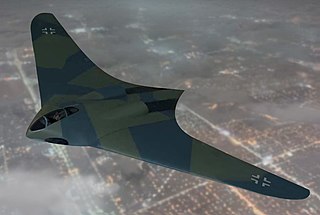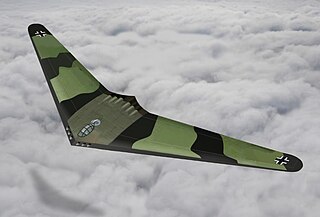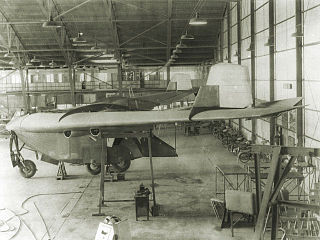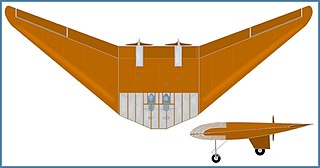
The Horten H.IX, RLM designation Ho 229 was a German prototype fighter/bomber initially designed by Reimar and Walter Horten to be built by Gothaer Waggonfabrik. Developed at a late stage of the Second World War, it was the first flying wing to be powered by jet engines.

The Horten H.XVIII was a proposed German World War II intercontinental bomber, designed by the Horten brothers. The unbuilt H.XVIII represented, in many respects, a scaled-up version of the Horten Ho 229, a prototype jet fighter. The H.XVIII was one of many proposed designs for an Amerikabomber, and would have carried sufficient fuel for transatlantic flights.

The Horten H.IV was a German tailless flying wing glider in which the pilot was to lie in a prone position to reduce the frontal area, and hence drag. It was designed by Reimar and Walter Horten in Göttingen. Four were built between 1941 and 1943. They were flown in a number of unofficial competitions in Germany during World War II. After the war the flying examples were transported to the United Kingdom and the United States where several contest successes were achieved.

The Arado Ar 76 was a German aircraft of the 1930s, designed as a light fighter with a secondary role as an advanced trainer in mind.

The DINFIA IA 38 was a 1960s Argentine four-engine experimental tailless transport aircraft, designed under the direction of Reimar Horten and based on the German Horten Ho VIII project and built by the DINFIA.

The Fauvel AV.22 was an unorthodox glider produced in France in the 1950s, 60s, and 70s. Originally intended to be produced in series, it was later marketed to homebuilders. Like other Charles Fauvel designs, it was a tailless aircraft, and this particular design featured wings with a slight forward sweep.
The Focke-Wulf Fw 47 Höhengeier, known internally to Focke-Wulf as the A 47, was a meteorological aircraft developed in Germany in 1931. It was a parasol-wing monoplane of largely conventional design, unusual only in the expansiveness of its wing area. Tested first by the Reichsverband der Deutschen Luftfahrtindustrie, and then the weather station at Hamburg, the type was ordered into production to equip ten major weather stations around Germany.
The Horten H.VI was a flying wing aircraft designed by the Horten brothers during World War II.

The I.Ae. 34 Clen Antú, sometimes known as the Horten XVa after its designer Reimar Horten, was a two-seat tailless glider built in Argentina. Two single-seat variants competed unsuccessfully in the 1952 World Gliding Championships.

The Gotha Go 147 was a German experimental two-seat tailless aircraft designed in 1936 by Gothaer Waggonfabrik and Dr. A. Kupper. Two examples were built and flown. Development was abandoned before the start of World War II.

The I.Ae.41 Urubú was a two-seat flying wing tailless glider, built in Argentina by the Fábrica Militar de Aviones (FMA) in the 1950s.

The Horten H.III was a flying wing sailplane built by Walter and Reimar Horten in Germany from 1937 to 1944.
The Nike PUL 9 is an Argentine experimental tailless aircraft powered by a Rotax 447 engine.

The Albatros L102 / Albatros Al 102, was a German trainer aircraft of the 1930s. It was a parasol-wing landplane, seating the student pilot and instructor in separate, open cockpits. A biplane floatplane version was also built as the Al 102W, with strut-braced lower wings.
The Albatros L 103 / Albatros Al 103 was a German experimental aircraft of the 1930s. It was a parasol-wing landplane of conventional configuration, seating the pilot and flight test observer in separate, open cockpits. The Al 103 was used to test variations in sweepback, dihedral and tailplane area.

The Horten H.V was a delta-winged, tail-less, twin-engined motor-glider designed and built in the late 1930s and early 1940s by Walter and Reimar Horten in Germany. The H.V aircraft were used for various experimental duties, including: innovative structure, performance, stability and control of flying wing aircraft. The first H.V was the first aircraft to be built using an all composite material structure.

The Horten H.I was a German flying wing research glider built by Walter and Reimar Horten in 1933.

The Fauvel AV.10 was a tailless light aircraft built in France by Charles Fauvel. A two-seater side-by-side and equipped with a 75 hp engine, it first flew in 1935. Designed by Charles Fauvel, it was his first powered aircraft, designed from the outset as that, to have been realised. In 1936, it had been exhibited at the 25th Salon de L'Aéronautique at the Grand-Palais of Paris. The AV-10 was a one-off design and disappeared in 1940, when it's believed it was taken by German troops.
The Horten H.VIII was a flying wing research aircraft designed by Reimar Horten during World War II and only partly built by the end of the war.

The Horten H.XIII was an experimental flying wing aircraft designed by the Horten brothers during World War II.















